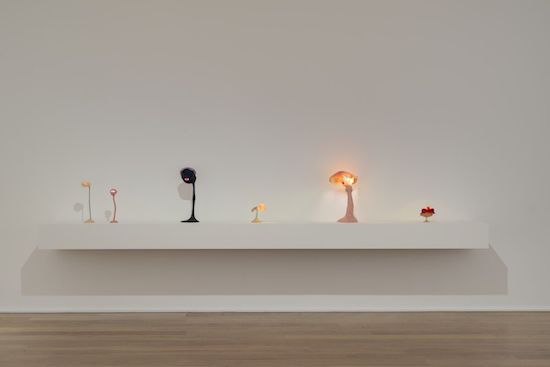Alina Szapocznikow, Noga (Leg, 1962, ©ADAGP Paris. Courtesy the estate of Alina Szapocznikow, Piotr Stanislawski, Galerie Loevenbruck, Paris. Photo: Thomas Barratt
‘To Exalt the Ephemeral, 1962–1972’, Hauser & Wirth’s first solo exhibition of the Polish-born artist Alina Szapocznikow, takes its title from a text she wrote in 1972: “My gesture is addressed to the human body, ‘that complete erogenous zone’, to its most vague and ephemeral sensations. I want to exalt the ephemeral in the folds of our body, in the traces of our passage.” The works on show – sculptures, ink drawings, photographs and her vital reckoning through words, all made during the last decade of Szapocznikow’s life in a period of intense, protean creativity – record and celebrate the human body: vulnerable, sensuous, ambiguous and unpredictable.
They are also decidedly un-monumental. Body parts are cast and reassembled, beings reduced to enigmatic elements made uncanny through their dismembered perfection. The exhibition starts with Noga (Leg) (1962), an immaculate white limb that represented a breakthrough for Szapocnikow, the first work in which she departed from her classical sculptural training in favour of casting in plaster directly from the body. Sans titre (Untitled) (1964–65), distils a face into a mouth born on a slender, unstable stem; its lips closed, it addresses its viewers with sphinx-like silence.
In Forma II (Form II) (1964–65), lips perch atop of a crab-like form made out of unfired, coral-pink clay. Self-portraits from 1966 conjoin the artist’s mouth, toes and the cloak-like contours of her chest to form curiously winged creatures cast in bronze. These mid-60s sculptures possess an animalistic presence, their anatomical elements reconfigured to form exotic organisms that rebuff the voyeuristic gaze with cool indifference. They contrast in spirit with a self-portrait from 1971, presented both in plaster and cast in waxen polyester resin, that sculpts the artist’s head as a bodiless, beached form – its delicate features seeming trapped and immobile.
All the works on view evoke the fragility of the human form. Szapocznikow’s life was bookended by tragedy: born in Poland in 1926, her teenage years were spent incarcerated in concentration camps surviving Auschwitz and Belsen through nursing others – a period she chose never to speak of. And she died aged just forty-six due to breast cancer after years of ill health.
Unsought poignancy stalks all her art and looms large in its reception. For the art historian Griselda Pollock, Szapocznikow’s oeuvre is an “encryption of trauma”; yet the artist used her situation and experience to explore the universal human condition, enshrining the creative gesture as both inherently absurd and convulsively necessary.

Installation View: ‘To Exalt the Ephemeral’ Hauser & Wirth, London 2020. ©ADAGP Paris. Photo: Alex Delfanne
Humour courses through many of the works, her sardonic, self-deprecating tone especially shining through her Lampe-bouche (Illuminated Lips) and Buste étincelant (Glowing Bust) sculptures of 1966 and 1967, which literally make light of their titular body parts. Using coloured polyester resin, light-bulbs and electrics and her own body as a template, these form functioning lamps that, in their gloriously kitsch aesthetic and fetishised female forms, are absolutely of their time while being eerily personal.
Using newly available synthetics and combining these with found objects such as nylon tights, gauze, photographs and hair, Szapocznikow’s sculptures convey a troubled materiality. Polyurethane, which hardens uncontrollably, and polyester become semi-translucent forms that are simultaneously flesh-like and artificial, disconcertingly coagulated. The artist described them as “awkward objects” out of sync with the “hero-miracle of our age, the machine.” So too, of course, is the human body, which Szapocznikow knew all too keenly. Viewed from the vantage point of the digital era, the analogue mode of her sculptural production, casting the textures and traces of existence, is especially striking. The finite, intensely inventive physicality of her works summons another era in which we related differently to the world.
In the late series Fotorzezby (Photo Sculptures) (1971), Szapocznikow’s focus turns from the body into the forms the body subconsciously makes, turning the most throwaway item into a mercurial sculptural object. Chewing gum is photographed in black and white and enlarged in prints, its chewed, elastic forms having been sculpted in the artist’s mouth, then suspended and drooping and stretching due to gravity. “I suddenly realised what an extraordinary collection of abstract sculptures was moving between my teeth,” Szapocznikow wrote in a text dated 22 June, 1971. “One only has to photography and enlarge my masticated creations in order to achieve a sculptural presence. Chew well then. Look around you. Creation lies just between dreams and daily work.”
Transience becomes transcendent in this powerful body of work – a source of joy as well as pain – which after decades of being largely overlooked is achieving due recognition. Represented by Hauser & Wirth, Szapocznikow’s radically innovative and highly distinctive sculptural language becomes part of a dialogue with the oeuvres of such twentieth century legends as Eva Hesse, Louise Bourgeois and Dieter Roth. Though to date her work has been less influential than these figures, it more than stands up to the comparisons.


